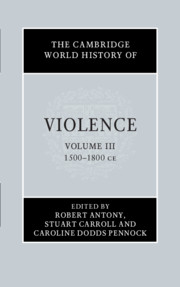Book contents
- The Cambridge World History of Violence
- The Cambridge World History of Violence
- The Cambridge World History of Violence
- Copyright page
- Contents
- Figures
- Maps
- Contributors to Volume iii
- Introduction to Volume iii
- Part I Empire, Race and Ethnicity
- Part II Cultures of War and Violence
- Part III Intimate and Gendered Violence
- Part IV The State, Punishment and Justice
- Part V Popular Protest and Resistance
- Part VI Religious and Sacred Violence
- 25 Religion and Violence in East Asia
- 26 Violence towards Heretics and Witches in Europe, 1022–1800
- 27 Intercommunal Violence in Europe
- 28 Violence, Animals and Sport in Europe and the Colonies
- Part VII Representations and Constructions of Violence
- Index
- References
25 - Religion and Violence in East Asia
from Part VI - Religious and Sacred Violence
Published online by Cambridge University Press: 13 March 2020
- The Cambridge World History of Violence
- The Cambridge World History of Violence
- The Cambridge World History of Violence
- Copyright page
- Contents
- Figures
- Maps
- Contributors to Volume iii
- Introduction to Volume iii
- Part I Empire, Race and Ethnicity
- Part II Cultures of War and Violence
- Part III Intimate and Gendered Violence
- Part IV The State, Punishment and Justice
- Part V Popular Protest and Resistance
- Part VI Religious and Sacred Violence
- 25 Religion and Violence in East Asia
- 26 Violence towards Heretics and Witches in Europe, 1022–1800
- 27 Intercommunal Violence in Europe
- 28 Violence, Animals and Sport in Europe and the Colonies
- Part VII Representations and Constructions of Violence
- Index
- References
Summary
Across East Asia, the period after the Mongol retreat was one of rebuilding and reordering. As they solidified political power, new regimes in China, Korea and Japan aggressively established authority over the religious realm, demanding compliance with moral and ritual norms, managing certain types of religious pluralism and violently crushing deviant devotion and organised religious resistance. Violence pervaded religion itself. Theological exploration of ideas such as cosmic destruction and rebirth, divine retribution, enforcer deities and the morality of killing for a greater good created stylised roles for both victims and perpetrators of violence. These themes manifested differently across the region. After Japanese militarists destroyed Buddhist mountain strongholds, lay armies defending the dharma fought with the ferocity of the faithful. Persecuted Christian converts willingly met martyrdom in the Catholic idiom. In China, the undercurrent of millenarian ideas that circulated through banned texts and teachings proved impossible to contain. These ideas could quickly militarise in response to stress, feeding a devastating cycle of rebellion and repression that continued through the eighteenth and nineteenth centuries. Across the region, temples and monasteries fought for resources, and religious affiliations often provided a spark for local tensions to erupt into organised violence.
- Type
- Chapter
- Information
- The Cambridge World History of Violence , pp. 493 - 512Publisher: Cambridge University PressPrint publication year: 2020



